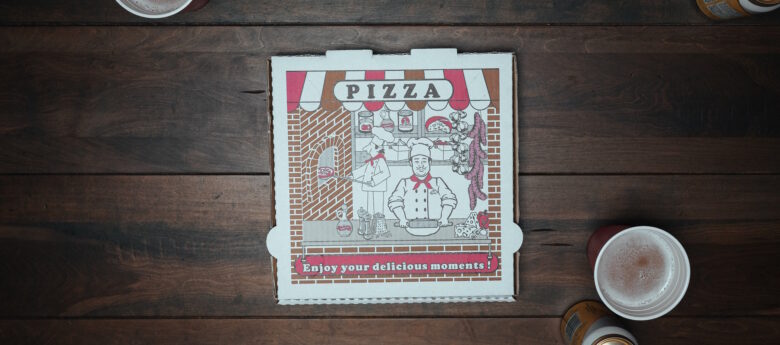Do Pizza Boxes Need Influencers?

Well, it sure helps when it comes to inspiring people to recycle pizza boxes.
That’s why three years ago, during the height of the pandemic, Google and Domino’s, the largest pizzeria in the world, teamed up. It allowed Google to promote its new smartphone. Domino’s to promote their brand and interest in pizza box recycling. And behind the scenes was another company, WestRock.
WestRock is the second largest manufacturer of corrugated boxes – the material of choice for pizza boxes – in the United States and a close business partner with Domino’s. WestRock started adding QR codes to the pizza boxes. The codes takes users to an informational page the company made which discusses why and how to recycle pizza boxes.
Here’s How It Worked
Online influencers selected by the corporate giants received a customized, hot Domino’s pizza and Google’s latest smartphone in a special compartment at the top of the box. The influencers were given instructions printed on the pizza box on how to explore their new smartphones while, at the same time, enjoying a slice of pizza. Domino’s also used the occasion to promote its efforts at teaching and encouraging consumers to recycle their pizza boxes.
The lucky influencers were encouraged to make videos using their new smartphone and post them on all their social media platforms. In the videos they would discuss what they liked about the phone, along with the importance of recycling pizza boxes.
Did It Work?
Well, if one of the criteria for success was impressions and viewers, yes, it did. With the help of a public relations firm, the campaign resulted in more than 65 million impressions and views in a very short time. But what does this have to do with facility managers? Quite a bit.
Many small and large companies and office buildings are doing everything they can to get people back in the office. While remote working has proven surprisingly effective, many organizations now believe they are losing their company “culture,” with their staff working just about anywhere but the office. So, one enticement some are using is pizza – pizza parties, to be more exact. And, at least in one case I am aware of, it’s working just fine.
A small financial services company in Chicago wanted their staff to come back to the office at least one day per week. With only 15 staffers, they thought it would be easy. But it wasn’t. Staffers wanted to continue to work at home.
To address this, the company began requiring all their staff to work in the office on Tuesday of each week. In exchange, the company would welcome them with a pizza party every Tuesday. Everyone came back to the office on Tuesday, working in the office and enjoying the pizza. Before anyone noticed, some staffers came back to work on Wednesday and Thursday as well. Most are now back in the office three days per week.
But this created another issue: should all those pizza boxes be tossed in the trash? With more organizations promoting and advocating for sustainability, that no longer was viewed as a viable option. So, many organizations are educating their staff and cleaning professionals about the importance of recycling the boxes and explaining why and how it can be done.
As part of the education process, managers, staffers, and cleaning professionals are learning:
- Domino’s has increased the recycled content of their pizza boxes from 40 percent to 72 percent. This tells us recycling works and is paying off.
- As mentioned earlier, pizza boxes are made from corrugated cardboard, a material already widely recycled in the U.S. An estimated three billion pizza boxes are used each year, totaling about 600,000 tons of corrugated cardboard. This cardboard ends up in overfilled landfills, where decomposition can take months to years.
- Some consumers believe used pizza boxes are too oily and greasy to be recycled. This is true if the box has a grease and oil content of about twenty percent or more. However, most used pizza boxes have an oil/grease content of about two percent, making them very recyclable. In fact, ninety-four percent of American Forest & Paper Association members now accept old, corrugated pizza boxes and corrugated containers for recycling and reuse.
- What is not recyclable is the paper, foil, or parchment used inside the box. This does need to be treated as trash, as does any pizza left in the box. But paper items stapled to the box – including the staples – should remain. Recycling systems can now remove the staples. They do not interfere with the recycling process.
Facility managers may also need some additional training. For instance, according to Michael Wilson, Senior Vice President for Business Development at AFFLINK, a network of distributors throughout the country, facility managers should take these actions:
- Work with local distributors to select the right-sized bins for recycling pizza boxes. Too small, and the pizza box won’t fit. Too large, and it will not be cost effective.
- Ask their distributors how the recycling bins should be cleaned. “They usually do not need to be disinfected or even sanitized,” Wilson says. “However, they do need to be wiped clean regularly, using an all-purpose cleaner or pressure washed using a garden hose and then wiped clean.”
Ask their distributors what local recycling centers do to recycle pizza boxes. While there are now many, some still do not accept pizza boxes for recycling. “Because our network of distributors is getting more educated on the importance of sustainability, it is more than likely they will know which recyclers accept the boxes,” says Wilson.
